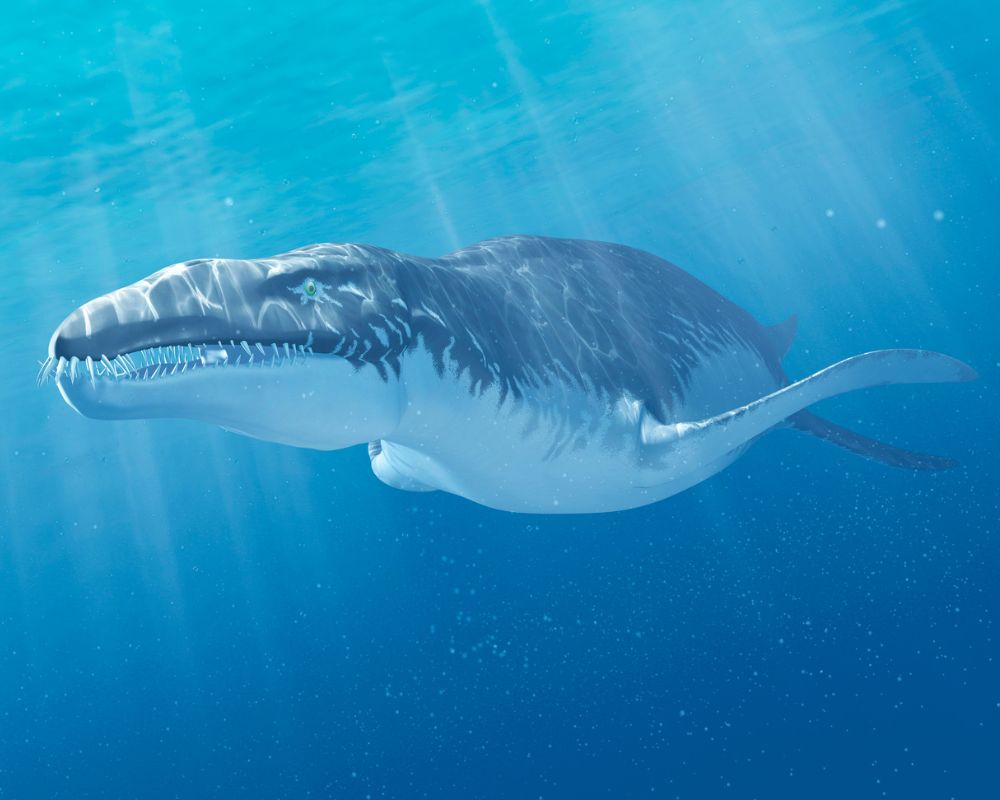In the battle between the Elasmosaurus and Liopleurodon, bigger was not always better. The Elasmosaurus was bigger, but the Liopleurodon would likely win due to a few key advantages.
Table of Contents
Battle Facts about Elasmosaurus vs. Liopleurodon

| Name | Elasmosaurus (Elasmosaurus platyurus), “ribbon lizard” | Liopleurodon (L. ferox), “smooth-sided teeth lizard” |
| Size | 34 feet in long, 4,400 pounds | 22 feet long, 3,700 pounds |
| Speed | 5 mph | 6.2 mph |
| Offense | Razor-sharp teeth like sharp needles for spearing prey | Powerful bite, quick in water |
| Defense | Long neck allows for great flexibility and movement in the water | Intense sense of smell |
| Endurance and Behavior | Slow, excellent swimmer | Heightened sense of smell allowed it to detect and stalk prey |
What was the difference between Liopleurodon and Elasmosaurus?
The Elasmosaurus and the Liopleurodon were plesiosaur dinos that slowly stalked for prey in the high seas. They lived in the ocean during the Jurassic and late Cretaceous periods and were both ferocious carnivores that dined on fish and other sea creatures like squids. However, these two were very different sea creatures.
The Elasmosaurus earned its name “ribbon lizard” for a good reason. Its long neck had 71 cervical vertebrae, making it look like a sea ribbon. It was long and graceful, with a heightened flexibility that helped it glide effortlessly through the water.
The Liopleurodon, on the other hand, had a very short neck. What it lacked in a neck, it made up with teeth. It had a massive skull 1/5 the size of its entire body and a bite that could make the T.Rex squirm. It had razor-sharp teeth and an enormous jaw. It wasn’t as good a swimmer as the Elasmosaurus, but it was faster.
How strong was the Liopleurodon’s bite force compared to the Elasmosaurus’?
The T-Rex would be in trouble if the Liopleurodon or Elasmosaurus could walk on land. The bite force of the Liopleurodon was a massive 33,000 pounds per square inch, which is the most brutal bite of any creature on the planet.
To put this bite force into perspective, the bite force of the mighty lizard king, the Tyrannosaurus Rex, was a mere 8,000 pounds per square inch. Additionally, the Elasmosaurus had the same bite force as the Liopleurodon.
Elasmosaurus vs. Liopleurodon: size comparison
Overall, the Elasmosaurus was longer and heavier than the Liopleurodon. The Elasmosaurus measured 34 feet long and weighed about 4,440 pounds. To understand its massive weight, the Elasmosaurus weighed two times as much as a modern Great White Shark!
The Liopleuronon was smaller, measured 22 feet long, and weighed 3,700 pounds. These marine reptiles were big but not nearly as big as pre-historic sea creatures like the Mosasaur or Pliosaurus.
What were some unique characteristics of the Liopleurodon?

The Liopleurodon had:
- Sharp teeth
- Great sense of smell
- Decent speed in water
The Liopleurodon had some pretty sharp teeth that measured 3 inches long. It used its sharp teeth to snare its prey and then chomp down like a crocodile. It was an apex predator of European seas that lived during the late Jurassic to the early Cretaceous period. The Liopleurodon had an amazing sense of smell that allowed it to sense predators and prey before seeing it.
In the water, it could reach a speed of just over 6 miles per hour. It may not seem very fast, especially when compared to land dinos like the Allosaurus or the Dilophosaurus. However, given its bulky size and massive head, it was surprisingly quick and agile in the water.
What were some unique characteristics of the Elasmosaurus?

The Elasmosaurus had:
- Heightened flexibility
- Long neck
- Great swimming ability
Elasmosaurus was one of the largest Plesiosaurs that ever lived. It had heightened flexibility with a massive body, strong flippers, and an unusually long neck. Its ability to bend its body made it a fantastic swimmer and an even better hunter.
The Elasmosaurus had an unusually long neck so heavy it couldn’t lift its head above water. Its neck had 71 vertebrae, which is more in all of Plesiosauria. For comparison, the highest number of vertebrae in most plesiosaurs was around 60.
Who would win Liopleurodon vs. Elasmosaurus?
In the battle between the Liopleurodon vs. Elasmosaurus, the Liopleurodon would be the clear winner. While the Elasmosaurus was larger, the Liopleurodon earned a slight edge over the Elasmosaurus for a few reasons.
First, the Liopleurodon had a heightened sense of smell, allowing it to detect the battle before it even began. It also had a massive jaw, which was a bigger portion of its body and delivered a more devastating bite.
Now, if faced with aggressive and bigger marine predators like the Tylosaurus, Mosasaurus, Megalodon, Kronosaurus, or Pliosaurs, the victory of the Liopleurodon might not have been as easy. Liopleurodon was a massive marine creature, but far bigger predators lurked in the ocean.
